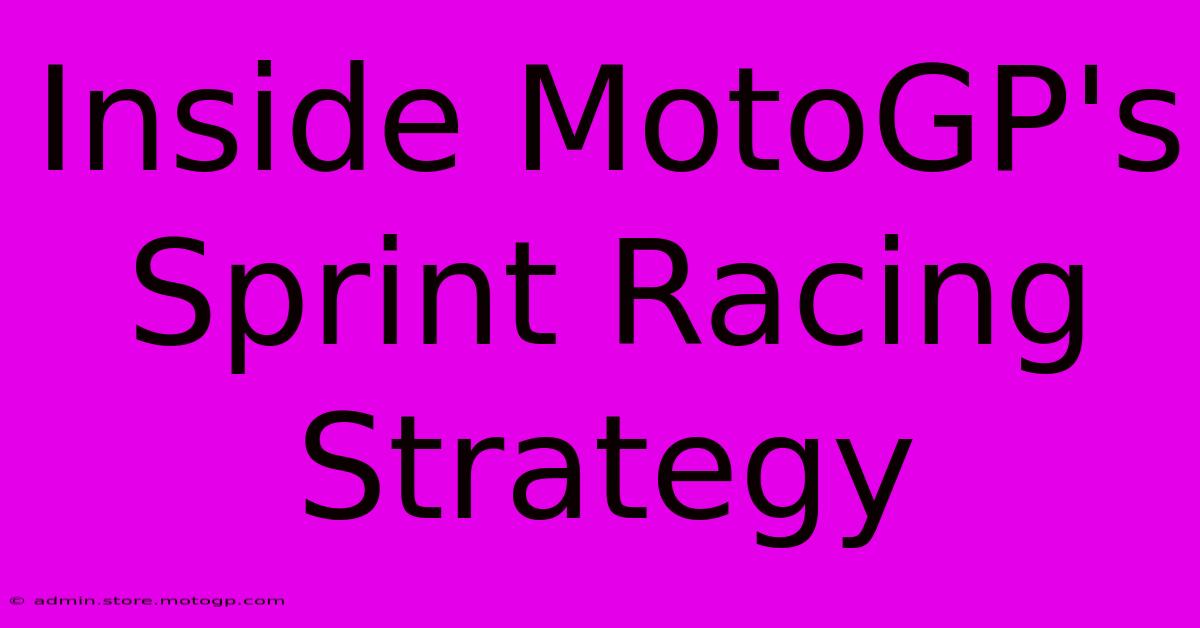Inside MotoGP's Sprint Racing Strategy

Table of Contents
Inside MotoGP's Sprint Racing Strategy: A Winning Formula?
MotoGP's introduction of sprint races has dramatically reshaped the weekend format, injecting a thrilling dose of high-stakes action into the already intense world championship. But what's the strategy behind these shorter, faster races? It's far more nuanced than just "go fast." This article delves into the complexities of sprint race strategies, examining the risks, rewards, and the impact on the main Grand Prix.
Understanding the Sprint Race Dynamics
Sprint races, typically held on Saturday, offer a significant chunk of championship points (12 for the winner down to 1 for ninth), making them a critical part of the overall equation. However, the shorter distance (a little over half the Grand Prix distance) drastically alters the strategic landscape. Tyre management, race pace, and even bike setup all take on a new dimension.
Tyre Degradation: A Major Factor
Unlike the longer Grand Prix, tyre management in sprint races is incredibly aggressive. Riders need to push hard from the start to secure a good position but must also carefully consider how much they can push before experiencing significant tyre degradation. A premature drop-off in performance can quickly ruin a race. Finding that balance is key to success. Aggressive early pace versus tyre longevity: this is the central dilemma.
Race Pace and Overtaking
Maintaining a consistent and fast race pace is crucial. Sprint races often see less overtaking opportunities than the main event due to the shorter duration and the aggressive racing. Qualifying position, therefore, becomes even more important. A good starting position is less about avoiding being overtaken and more about avoiding getting stuck in a traffic jam that could ruin your race.
Bike Setup: A Balancing Act
The ideal setup for a sprint race isn't necessarily the same as for a full Grand Prix. Teams often have to compromise, focusing on a setup that allows for maximum performance over the shorter distance while still protecting the tyres. Finding the sweet spot requires meticulous data analysis and rider feedback.
The Impact on the Grand Prix Strategy
The sprint race significantly impacts the strategy for the main Grand Prix on Sunday. A strong performance in the sprint can build rider confidence, secure a better grid position, and provide valuable data for the longer race. Conversely, a poor result could put a rider on the back foot for the main event.
Data Gathering: A Valuable Tool
The sprint race acts as an extended practice session. Teams can gather crucial data on tyre wear, bike performance, and race pace. This information allows them to fine-tune their setup and race strategy for the Grand Prix, maximizing their chances of success.
Grid Position: The Importance of Saturday
A good sprint race result translates directly into a better grid position for the main Grand Prix. This is a massive advantage, significantly reducing the need for risky overtaking maneuvers and allowing riders to focus on managing their race pace. This is especially crucial in MotoGP where overtaking is notoriously difficult.
Psychological Impact: Confidence Booster
Winning or even achieving a strong result in the sprint race can significantly boost a rider's confidence heading into the Grand Prix. This mental advantage can be just as important as any strategic advantage. Conversely, a bad sprint race can affect a rider's morale and affect their performance on Sunday.
The Future of Sprint Races in MotoGP
The sprint race format is still relatively new, and its long-term impact on MotoGP remains to be seen. While it's added a significant layer of excitement and unpredictability to race weekends, ongoing analysis and adjustments will likely continue to fine-tune the format and its rules to ensure a balanced and engaging competition.
In conclusion, MotoGP's sprint races have added a new layer of strategic complexity to the sport. Understanding the nuances of tyre management, race pace, and the impact on the main Grand Prix is crucial for success. The sprint race isn't just a warm-up; it’s a high-stakes battle that can significantly shape the overall outcome of a race weekend. The interplay of short-term gains and long-term strategy creates an incredibly exciting and unpredictable element in the world of MotoGP.

Thank you for visiting our website wich cover about Inside MotoGP's Sprint Racing Strategy. We hope the information provided has been useful to you. Feel free to contact us if you have any questions or need further assistance. See you next time and dont miss to bookmark.
Featured Posts
-
Moto2 A Celebration Of Innovation And Speed
Feb 18, 2025
-
Formula 1 Parking The Ultimate Convenience
Feb 18, 2025
-
Austin F1 Qualifying The Heat Is On
Feb 18, 2025
-
Motorcycle Racing Beyond The Limits
Feb 18, 2025
-
How Fast Is A Moto Gp Bike In Kph
Feb 18, 2025
